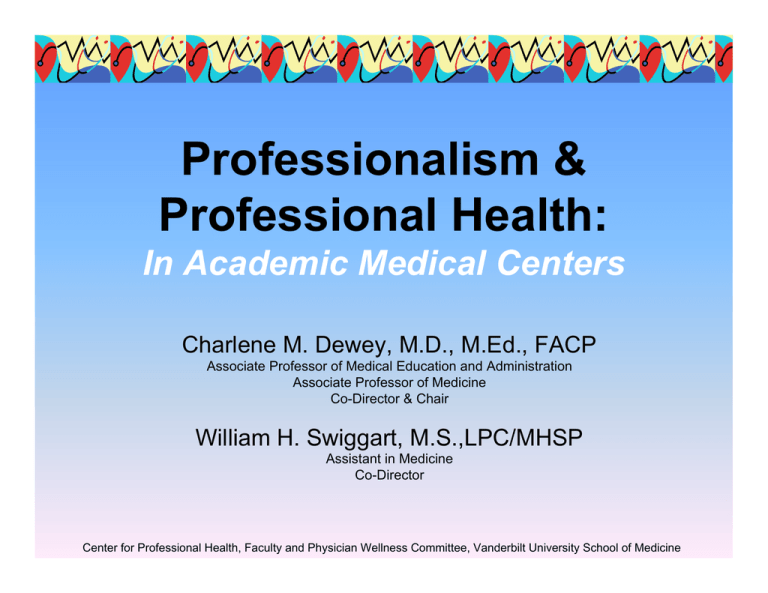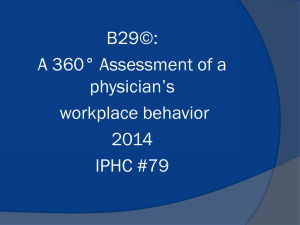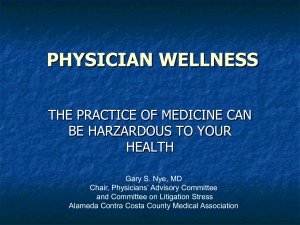Professionalism & Professional Health: In Academic Medical Centers
advertisement

Professionalism & Professional Health: In Academic Medical Centers Charlene M. Dewey, M.D., M.Ed., FACP Associate Professor of Medical Education and Administration Associate Professor of Medicine Co-Director & Chair William H. Swiggart, M.S.,LPC/MHSP Assistant in Medicine Co-Director Center for Professional Health, Faculty and Physician Wellness Committee, Vanderbilt University School of Medicine Purpose • Provide an overview of key resources at Vanderbilt. • Raise awareness of issues related to professionalism and professional health. • Describe common problems encountered. • Discuss how we at Vanderbilt will address such problems in the future. Participant Objectives • List key issues of professionalism and professional health. • Describe common external and internal factors that contribute to lapses in professionalism. • List resources available for faculty and physicians at Vanderbilt. Vanderbilt Internal Resources Abbrev. Program Focus Contact Number FPWC Faculty and Physician Wellness Committee All issues of professional health Charlene Dewey x6-0678 FPWP Faculty and Physician Wellness Program – Work/Life Connections EAP Treatment of faculty and employees Mary Yarbrough X6-1327 CPH Center for Professional Health Training physicians Bill Swiggart x6-0678 VCAP Vanderbilt Comprehensive Assessment Program for Professionals Fit for duty assessments and treatment Reid Finlayson X2-4567 CPPA Center for Patient and Professional Advocacy Identification and assistance Jerry Hickson X3-4500 Faculty and Physician Wellness Committee (FPWC) Rahn K. Bailey, M.D. – MMC Chad Boomershine, M.D. Donald W. Brady, M.D. Ildiko Csiki, M.D. (resident) Larry Churchill, Ph.D. Roy Elam, M.D. A.J. Reid Finlayson, M.D. Kimberly Garcia, M.D. (resident) Stephan Heckers, M.D. Gerald B. Hickson, M.D. Jerry Jaboin, M.D. (resident) Tracy Jackson, M.D. Peter Martin, M.D. Jeanette J. Norden, Ph.D. James O’Neill, Jr., M.D. Paul W. Ragan, M.D. David S. Raiford, M.D. Scott M. Rodgers, M.D. Debbie Smith, M.A. William Swiggart, M.S., LPC/MHSP Donna Seger, M.D. Anderson Spickard, Jr., M.D. Mary Yarbrough, M.D., MPH Charlene M. Dewey, M.D., M.Ed., FACP (chair) Key Educational Goals – FPWC • To develop, present and publicize educational programs • To oversee the strategic plan to promote physical, emotional, spiritual and mental wellness • To address uncontrolled stress, anxiety and depression, substance abuse, physical illness, career difficulties and family problems • To contribute to the body of scholarship on wellness Center for Professional Health (CPH) “What a journey this has been! What started out as a punishment has turned out to be a fantastic gift; truly a life changing opportunity.” ~CPH Participant 07-08 Center for Professional Health (CPH) • Started courses in 1998 as CPH • Three CME courses: – Maintaining Proper Boundaries – Prescribing Controlled Drugs – Program for Distressed Physicians • Over 1,200 physicians trained Demographic of the Courses Courses N Ave Age Sex Distressed 76 48 12% F 88% M Boundaries 504 41 5% F 95% M Prescribing 661 50 11% F 88% M Total Distressed 1241 Boundaries Prescribing IM specialties* IM/FP IM/FM IM/FM Psychiatry Psychiatry OB/GYN Surgery Surgery Surgery OB/GYN ER *(interventionalists) Burnout, Depression and Suicide One physician commits suicide every day! Case 1: It’s 7:30 PM and you pass your colleague’s office. She is a 42 yo female physician, recently divorced with three kids. You can tell she was crying. When you ask what is wrong she shapes up and replies, “Nothing really. I am so frustrated with the system!” You offer to talk and she declines. •What are her risk factors for burnout? Professional Health Spectrum • • • • Wellness & balance Work-place stress & burnout Mental health: depression & substance use Suicide High Functioning High Productivity Fair Functioning Decreasing Productivity Fair Functioning Reduced Productivity Relationships Suffer Fair-Not Functioning Fair-Not Productive Institution & Family Loses Burnout “In the current climate, burnout thrives in the workplace. Burnout is always more likely when there is a major mismatch between the nature of the job and the nature of the person who does the job.” ~Christina Maslach The Truth About Burnout: How Organizations cause Personal Stress and What to Do About It. Maslach & Leiter pg 9; 1997 What is workplace stress & burnout? • Mismatch between the individual and the environment • Results from: reduced control, over-involvement, lack of rewards/recognition, doubt, guilt, narcissism, lack of resources, no sense of community, unfair treatment, mismatched values • Results in: emotional exhaustion; isolation; impaired productivity; avoidance; feelings of cynicism; interpersonal conflicts; high turnover Risk Factors for Burnout • • • • • • Single Gender/sexual orientation ># of children at home Family problems Mid-late career Previous mental health issues (depression) • Fatigue & sleep deprivation • General dissatisfaction • Alcohol and drugs • Minority/international • Teaching & research demands • Potential litigation Puddester D. West J Med 2001;174:5-7 Myers MJ West J Med 2001;174:30-33 Gautam M West J Med 2001;174:37-41 Protective Factors • Personal: • Work: – Influence happiness through personal values and choices – Spend time with family & friends – Engage in religious or spiritual activity – Maintain self-care (nutrition & exercise) – Adapt a healthy philosophy/outlook – A supportive spouse or partner – Gain control over environment & workload – Find meaning in work – Set limits and maintain balance – Have a mentor – Obtain adequate administrative support systems Spickard, Gabbe & Christensen. JAMA, September 2002:288(12):1447-50 Risk Factors Resilience Wellness Burnout Case 2: Dr S has struggled for the last few years to keep his lab funded by external support. He has collaborators and fellows in his lab. He has had several episodes of missing deadlines and calling in sick. His best post-doc is interviewing for another position and two students have asked to be reassigned. As a colleague who works in another area, you often hear his lab partners complain about him missing meetings and not responding to emails. You know Dr S but would not consider him a close friend. • What are you concerned with here? What barriers may play a role in this case? Suicide • “However, hard and stressful work alone does not result in suicide. Those who do commit suicide almost always have significant identifiable underlying mental illnesses, such as major depression and/or bipolar disorders, usually coupled with alcoholism and major drug use.” ~Eugene V. Boisaubin Faculty Health in Academic Medicine: Physicians, Scientists, and the Pressures of Success. Pg 32; 2009 Suicide • • • • • • • Grossly underestimated MDs > other professions & general pop. One physician per day; PhD – unclear F>M Reduced use of care by physician Depression/bipolar Stigma “High physician suicide rates suggest lack of treatment for depression.” - MD Consult News June 11, 2008 Suicide • Dr. W. Gerald Austen, surgeon-in-chief emeritus at Massachusetts General Hospital, “It wasn’t as if the institution and the department weren’t aware that they had some problems,” he said in an interview. • “Friends who work with people in medicine need to be aware that, if they see something that concerns them, they need to transmit the message to the powers that be.” “Good Boundaries Make Good Physicians.” Case 3: Dr B has been bragging about a new relationship with a very attractive 4th year student. You hear a patient complaining to the clinic nurse that Dr B was “curt” and made sexual comments about her body. Dr B has been known to “hang out” with the residents at happy hour and is “the life of the party.” In casual conversation, Dr B described having to write a prescription for lortab after the 4th year student sustained an injury during the senior class softball game. • Who did Dr B have sex with? Boundary Violations “In every house where I come I will enter only for the good of my patients, keeping myself far from all intentional ill-doing and all seduction and especially from the pleasures of love with women or with men, be they free or slaves.” ~The Hippocratic Oath http://en.wikipedia.org/wiki/Hippocratic_Oath Sexual Behavior Continuum Personal/Professional Boundaries “Slippery Slope” Misconduct Restrictive Excessive Healthy on ati t ig k Li Ris lem ob Pr ue Iss ern nc Co A. Spickard, Jr., G. Manley, W. Swiggart – Maintaining Proper Boundaries Course-CPH 2008 Slippery Slope Behaviors Late appointments Personal gifts Social engagements; dates Special favors Flirting, jokes etc. Grooming behavior Casual Warning: Slippery Slope Behaviors workplace Misconduct Adapted from-Swiggart, W. - Maintaining Proper Boundaries-CPH Course 2008 Boundary Violations • Sexual Misconduct – two types: – Sexual impropriety – Sexual violation • MD-Pt sex, whether or not initiated by the patient, and engaging in any conduct with a patient that is sexual or may be reasonably interpreted as sexual. • Having sex with a pt is a breech of the healing covenant ~Federation of State Medical Boards of the US, INC. A. Spickard, Jr., G. Manley, W. Swiggart – Maintaining Proper Boundaries Course-CPH 2008 Boundary Violations • The physician is always responsible for the boundary violation… – A pt cannot give informed, mutual, or meaningful consent… – Employees & hospital staff also cannot truly consent… …because of the “Power Imbalance.” A. Spickard, Jr. , G. Manley, W. Swiggart - Maintaining Proper Boundaries Course - CPH 2008 Prescribing Boundaries • Family members & friends • Recurring patterns: – Large quantities & frequent intervals without legitimate purpose – Failure to screen for A/D problems – Multiple pharmacies – Knowing pt gives to others – In exchange for sex – Inadequate records DEA Practioner’s Manual pg 30 - Baron, M. - Prescribing Controlled Drugs – CPH 2009 Distressed Physicians “This leadership course has brought about change in the way I perceive others and how I am perceived as a professional, husband and father. This intervention should have occurred earlier.” ~CPH participant 07-08 Case 4: Dr D is an OB/GYN who has been fired from one residency program. She joined the faculty 6 mo ago. Since then, she has had five pt and staff generated complaints about her aggressive, loud behavior. In stressful situations, she becomes loud, forceful and rude. She slammed the door after a heated discussion with a nurse in front of a patient. She has also changed OR times without team permission to “take care of VIP patients.” • Are her behaviors ok if her skills are outstanding? Distressed Physicians • Internal Factors • External Factors – Alcohol and drug addiction – Compulsive behavior around sexual acting out, compulsive gambling, eating, working, etc. – Little or no training in conflict resolution, leadership skills, communication and teaching skills – Psychiatric disorders • Narcissistic personality disorder • Depression/bipolar • Dementia etc. Swiggart, Dewey, Hickson, Finlayson. Accepted, 3/09 – High system demands and low system support – Disruptive behavior is reinforced by the system – Bully doc gets preferential operating time – Masking ineffective managers – Failure to act – The system fails to provide physician with complaints and/or feedback – Life cycle events (i.e. death in the family, children leaving home, divorce, etc.) Figure 1 Spectrum of Disruptive Behaviors Aggressive Inappropriate anger, threats Yelling, publicly degrading team members Intimidating staff, patients, colleagues, etc. Pushing, throwing objects Swearing Outburst of anger & physical abuse Passive Passive Aggressive Hostile notes, emails Derogatory comments about institution, hospital, group, etc. Inappropriate joking Sexual Harassment Complaining, Blaming Swiggart, Dewey, Hickson, Finlayson. Accepted, 3/09 Chronically late Failure to return calls Inappropriate/ inadequate chart notes Avoiding meetings & individuals Non-participation Ill-prepared, not prepared The Future of Professional Health at Vanderbilt Educational & System Issues: 1. 2. 3. 4. 5. 6. 7. 8. Educational venues Suicide prevention & awareness Course assessments Prescribing policies & StarPanel dashboard CPH web-resources for professionals Hazardous Affairs DVD & training manual Transitions education and training Go for the Gold – stress video Research: IRB Approved Studies 1. 2. 3. 4. Needs assessment & resource identification SP case development FACES II (family of origin study) Work Environment Survey a work-place monitoring tool 5. Suicide awareness and prevention survey* 6. Retiring physicians survey & focus groups* *IRB pending or in submission process Summary • We are all prone to challenges in our careers. • Vanderbilt has means of addressing issues when they occur. • We plan to implement more options to inform & protect our faculty. • Please feel free to contact us: – Charlene.dewey@vanderbilt.edu – Wiliam.swiggart@vanderbilt.edu CPH & FPWC Web Page http://www.mc.vanderbilt.edu/cph CPH FPWC Center for Professional Health * 1107 Oxford House * x6-0678

